The Naish Wing Surfer: A Deep Dive into Performance and Design
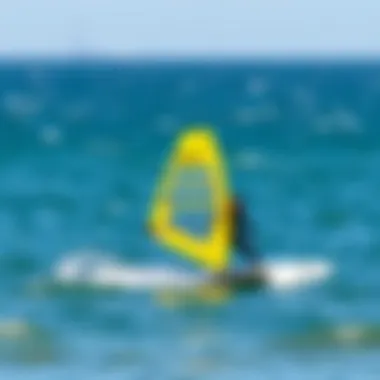
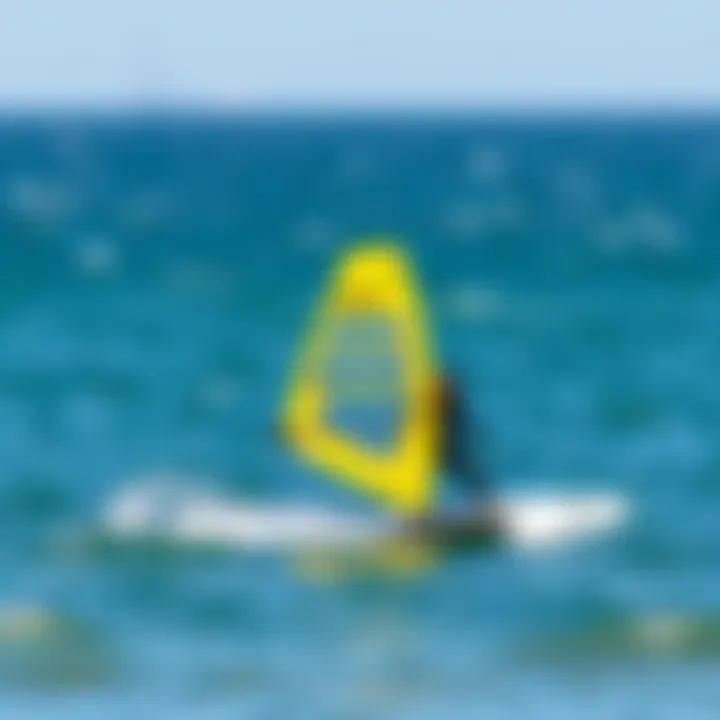
Intro
As the tides of water sports continue to evolve, the Naish Wing Surfer has emerged as a game changer for those attracted to the thrill of wing foiling, surfing, and kiteboarding. This piece of equipment doesn't merely accompany riders; it elevates their experience, making each wave a canvas where skills and creativity blend. For beginners figuring their way through the early stages, to seasoned athletes who thrive on adrenaline, understanding the specifics of the Naish Wing Surfer is essential.
In this exploration, we will navigate through the intricate details of gear selection, essential skills development, and the broader eco-system of wing surfing. We aim to provide an insightful understanding that caters to both new and experienced practitioners alike. Whether you're looking to enhance your selection process or simply wanting to fine-tune your skills, this guide will serve as your compass in the expansive sea of wing surfing.
Gear Selection
The foundation of any successful water sport adventure is having the right equipment, and when it comes to the Naish Wing Surfer, this couldn’t be more true. Selecting the right gear ensures not just performance but also safety and enjoyment on the water. Let's break down the crucial components.
Types of Kites
The various kite options available can be overwhelming, but understanding their characteristics can simplify matters. Each kite holds specific trade-offs depending on factors such as wind conditions and rider experience. Here’s a concise look at common kite types:
- Delta Kites: These are known for their stability and versatility, excellent for beginners and intermediates. Delta shapes remain firm and handle gusty winds well, making them a popular choice.
- Sled Kites: While not as widely used for wing surfing, sled kites offer broad surfaces that can be beneficial for static lift, allowing for unique flying experiences, especially close to the water’s surface.
- C Kites: Known for their responsiveness and performance, C kites cater more to advanced riders who thrive on aggressive maneuvers and high-speed performances. They excel in stronger winds.
Choosing the right kite involves considering individual style, skill level, and the conditions you'll be riding in.
Choosing the Right Board
Just as important as your kite is the board you stand on. The Naish Wing Surfer model features several boards, each designed for distinct riding styles. Here are some aspects to consider:
- Board Type: Lightweight boards help beginners ride smoother, while heavier boards can be more stable and suitable for advanced maneuvers.
- Size: Generally, larger boards provide more floatation, making it easier to start wing foiling or surfing. Smaller boards, though more challenging, allow for sharper turns and tricks once confidence builds.
- Shape: Different shapes can affect speed, stability, and maneuverability. Consider your goals.
Summary of Gear Selection
In summary, موفق gear selection centers on understanding each component’s role in enhancing your performance and experience. Choosing the right kite type and board is not just a technical decision; it's about matching your equipment to your personal style and the wind conditions you face.
Skill Development
Understanding your gear is only half the battle. Skill development is where true progression happens. From the moment you step onto the water with your Naish Wing Surfer, mastering essential techniques can open up new avenues of enjoyment.
Essential Techniques
Diving into the world of wing surfing, certain core techniques will bolster your confidence and skill level:
- Launching and Landing: Ensure you have a safe area for launching and landing. Position yourself correctly to handle the kite, avoiding potential mishaps.
- Wing Control: Start with basic movements, learning how to steer effectively while balancing momentum. This helps develop confidence.
- Riding Stance: Maintain a balanced stance on the board. Finding your center of gravity can significantly affect your stability.
Progression Tips
As you grow comfortable with the basics, moving to advanced techniques is vital. Here are a few tips to help elevate your wing surfing:
- Practice Foiling: Once you master traditional surfing, consider trying a foil. Foiling enhances speed and offers a new level of thrill when riding.
- Explore Different Conditions: Experiment with various wind strengths and water types. Each scenario provides a learning opportunity, shaping flexibility in riding styles.
- Join Communities: Engaging with local riders or online forums can provide insights and encouragement. Share experiences, learn from others, and find mentorship.
"The beauty of wing surfing is not just in riding but in constant learning and sharing with fellow enthusiasts."
Finale
The Naish Wing Surfer stands at the intersection of innovation and tradition in water sports. Proper gear selection enhances your experience, while skill development paves the way for memorable sessions on the water. Riding offers more than just enjoyment; it encompasses a community of passionate individuals sharing their love for the sport. Embracing this journey means not just accepting the challenges but actively seeking them out. For additional information on wing surfing, communities like Reddit host valuable discussions, while resources like Wikipedia offer foundational knowledge to further enrich your journey.
Let’s lace up, hit the waves, and make each wind-filled adventure one for the books!
Intro to the Naish Wing Surfer
The Naish Wing Surfer stands as a pivotal piece of equipment in the realm of water sports, particularly for those intrigued by wing foiling, surfing, and kiteboarding. Tailored for a diverse range of enthusiasts, from newcomers to seasoned pros, it offers an incredible blend of performance, durability, and ease of use. This section aims to elucidate the significance of the Naish Wing Surfer, delve into its unique attributes, and spotlight core considerations for individuals curious about mastering this exciting sport.
The Evolution of Wing Surfing
Wing surfing has undergone a remarkable transformation since its inception, transitioning from an experimental pursuit to a mainstream water sport. The past few years have marked a surge in popularity, largely driven by innovations like the Naish Wing Surfer. Originally, wing surfing drew from windsurfing and kiteboarding principles but distinctly carved its own niche. This evolution reflects a communal spirit among water sports enthusiasts, with shared techniques, tips, and experiences fed through social platforms and rider meet-ups.
Today, the sport boasts various styles and approaches that cater to different preferences. Riders can now traverse the open sea, tackle waves, or glide across flatwater, all with varying wing sizes and shapes tailored to their specific needs. Each of these styles has found a loyal following, and discussions surrounding performance, equipment, and rider skill levels flourish within the community. It's not just about the thrill of the ride but also about connecting with others who share the same passion.
Naish's Design Philosophy
Naish has held a significant position in the water sports industry for decades, and their design philosophy exemplifies a blend of innovation, functionality, and aesthetics. The brand subscribes to the idea that every piece of equipment should enhance a rider's experience on the water. The engineers design each component of the Naish Wing Surfer with the utmost attention to detail, focusing on lightweight materials that don’t compromise strength and stability.
In practice, this means delivering a wing surfer that engages riders of all skill levels. Features such as comfortable handles and a user-friendly inflation system reflect a commitment to accessibility. The team dedicates resources to understanding rider feedback, allowing them to iterate designs that continually meet or exceed user expectations.
In summary, the Naish Wing Surfer is not merely a tool for riding the waves; it embodies a culture rooted in progress and community involvement, inviting riders to explore the water with confidence. Through examining its evolution and the philosophy behind its design, readers will gain insight into how this remarkable equipment can significantly enhance their wing surfing experience.
Understanding the Components of the Naish Wing Surfer
In the realm of water sports, the structure and function of equipment can make or break the experience. For enthusiasts diving into the world of wing surfing, the Naish Wing Surfer stands out not only for its sleek design but also for the innovative components that contribute to its performance. Understanding these components is crucial for anyone looking to get the most out of their experience, from ensuring stability in various wind conditions to facilitating easier maneuverability on the water.
Wing Structure and Materials
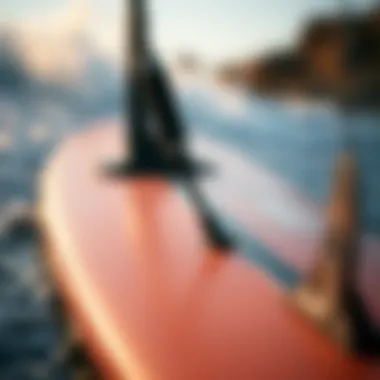
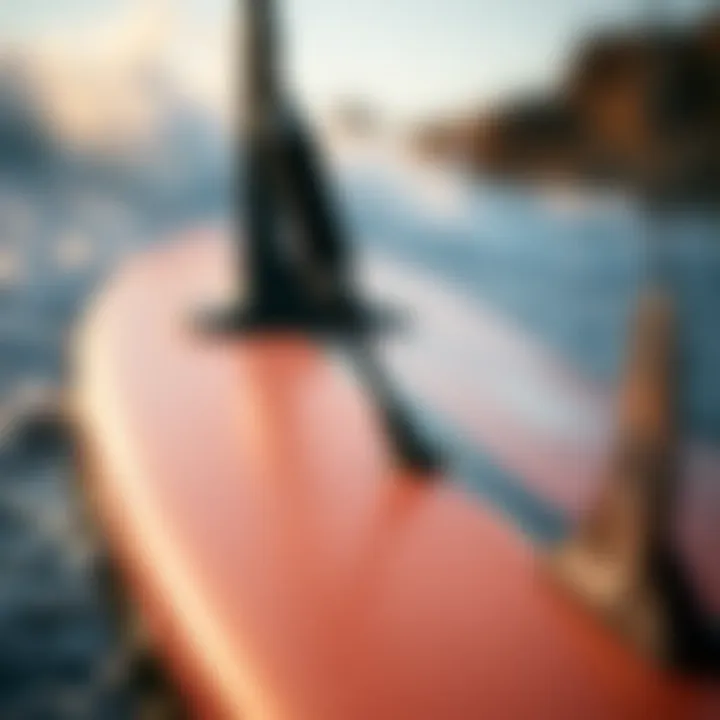
The wing of the Naish Wing Surfer is the heart of the activity, defining how rideable it behaves on the water. Made from durable and lightweight materials, its structure is designed to withstand strong winds while remaining easy to control. The leading edge, often crafted with a tough TPU, provides the necessary rigidity without adding excessive weight. This balancing act is key; it allows the user to harness wind power efficiently while minimizing fatigue during prolonged sessions.
- Durability: Using tear-resistant materials ensures that the wing holds up against the elements and frequent use.
- Weight Considerations: A light structure enhances lift and maneuverability, which is especially vital when making sharp turns or optimizing speed.
- Shape Dynamics: The curvature of the wing impacts how it captures the wind and translates that into lift. The Naish Wing Surfer features a unique design that allows for rapid acceleration without compromising stability.
Handles and Straps: Overview
The handles and straps on the Naish Wing Surfer offer riders a direct line of control over their wing, ensuring they can make precise adjustments in their posture and, consequently, their trajectory. These components are ergonomically designed, allowing for a comfortable grip even during prolonged use. Causing less strain on the hands makes it easier for both beginners and seasoned veterans to focus on mastering their moves.
- Adjustability: The placement of handles may be modified, which accommodates different styles of riding and personal preferences.
- Comfort: Padded straps are an essential consideration; they reduce the chance of blisters and discomfort when gripping tightly.
- Safety Features: Many models integrate quick-release mechanisms. This is especially important, as it lets riders release the wing in a moment of need.
Inflation and Deflation Mechanisms
The inflation and deflation mechanisms of the Naish Wing Surfer are cleverly engineered to ensure hassle-free setup and pack-down processes. Quick inflation gives users more time on the water, and understanding how to utilize these mechanisms can impact performance significantly.
A dual-valve system is often employed in these wings, helping them achieve optimal inflation levels with minimal effort. The large opening facilitates swift air intake, while one-way valves prevent air from escaping once it's inflated.
- Inflation: Many riders appreciate the robustness of the air pockets; they maintain the wing's shape effectively under various winds.
- Deflation: Easy-to-use release valves allow for quick deflation after a day of water sports, which simplifies storage.
- Portability: Both processes are designed with ease of use in mind, leading to a more enjoyable overall experience. Riders can quickly pack up and be on their way without annoying delays.
In wrapping up this section, it's crucial to recognize that the individual components of the Naish Wing Surfer contribute not only to its performance but also shape the overall experience of wing surfing. The understanding of these features can help riders make informed decisions, ensuring they select a model that aligns with their specific needs and preferences.
"The beauty of wing surfing lies not just in the ride, but in knowing your equipment inside and out. Having a handle on the nuances allows you to glide with confidence and style."
For those keen to learn more, resources such as Wikipedia and Britannica can provide deeper insights into the mechanics and culture surrounding wing surfing.
Performance Characteristics
The performance characteristics of the Naish Wing Surfer are crucial in understanding its appeal to both beginners and seasoned athletes. This component encompasses multiple factors such as stability, speed, control, and adaptability in various wind conditions. Each characteristic significantly influences how a rider experiences the water, making this aspect highly relevant for anyone looking to excel in wing surfing.
Stability and Control
Stability is a fundamental aspect of the Naish Wing Surfer. An effective wing surfer must provide a stable platform to ride on, especially during changing wind conditions. A well-designed wing balances surface area and shape to deliver optimal stability. A significant factor in this is the wing's aspect ratio; wings designed with a higher aspect ratio tend to glide better and resist turbulence from sudden wind shifts.
Additionally, control plays a pivotal role in rider performance. Handles must allow for quick adjustments, enabling the rider to manage the wing's position effectively against the pull of the wind. This connection is what separates skilled riders from novices. Riders who can subtly shift their weight while gripping the handles gain a fuller understanding of their board's dynamics—ultimately giving them a commanding presence on the water.
"In the world of wing surfing, stability and control aren't just about balance; they're about mastering the wind to dance across the surface of water."
To maximize stability and control, riders should experiment with different wing sizes to match their weight and skill level. Generally, a larger wing provides more lift and is more forgiving for beginners, whereas advanced riders may prefer a smaller wing for maneuverability.
Speed and Maneuverability
When it comes to speed, the Naish Wing Surfer excels thanks to its efficient profile and innovative materials. The wing's design promotes direct sail-to-wing interaction, which reduces drag while allowing for quicker acceleration. Riders will find that the responsiveness can be quite exhilarating, encouraging them to push their limits.
Maneuverability also plays an essential role, particularly in competitive environments or when navigating tighter channels and waves. The Naish Wing Surfer provides a range of turn dynamics, from sharp pivots to long, sweeping arcs. This versatility allows a rider to shift their style seamlessly from racing against the wind to carving elegant turns on a wave.
For optimal speed, riders should focus on maintaining a low center of gravity and adopting a streamlined stance. This reduces wind resistance and enhances speed, giving the rider an edge on choppy waters.
Wind Range and Conditions
Understanding the wind range and conditions is imperative for effective wing surfing. The Naish Wing Surfer is engineered to perform across a spectrum of wind conditions, making it suitable for various environments. From gentle breezes to stronger gales, the right wing selection can make a world of difference.
- Light Winds: In lighter winds, riders should opt for larger wings, which harness the minimal wind power and deliver maximum lift. This allows for ample buoyancy, making it easier to ride.
- Moderate Winds: For moderate conditions, riders can switch to medium-sized wings, which balance speed and control.
- Strong Winds: In strong wind conditions, smaller wings are preferred to maintain agility and responsiveness. They enable riders to navigate without being overpowered by the elements.
Knowledge of projected wind patterns can also influence choice and performance. Advanced riders can read the water's surface to predict changes in wind conditions, adapting their technique accordingly. Understanding these dynamics not only enhances individual riding but also fosters greater respect for the environment in which wing surfing is practiced.
In summary, the performance characteristics of the Naish Wing Surfer illustrate the critical elements that contribute to a rewarding experience on the water. Stability and control pave the way for safety and skill development, while speed and maneuverability enable exploration and creativity. Recognizing the impact of wind range and conditions helps riders harness the elements and make the most of their time spent wing surfing.
Selecting the Right Naish Wing Surfer
Choosing the correct Naish Wing Surfer can make or break your experience on the water. This selection is not just about personal preference but involves understanding various factors that can influence performance and enjoyment. From the size and weight of the wing to one's skill level, making informed decisions ensures that you have the right equipment for your specific needs. Let's delve into the important elements, benefits, and considerations that come with selecting the right Naish Wing Surfer.
Sizing Considerations
When it comes to wings, size matters a whole lot. The size of the wing not only affects how easy it is to control but also influences your speed and the range of wind conditions you can tackle. Generally, larger wings offer better lift in lighter winds, making them a go-to for beginners or those who prefer calm conditions. Conversely, experienced riders might opt for smaller wings, which are more maneuverable and suitable for stronger winds, allowing for quicker turns and tricks.
Here’s a helpful way to think about wing sizing:
- Beginner: 6-8 square meters, ideal for lighter winds
- Intermediate: 4-6 square meters, adaptable for various conditions
- Advanced: 3-4 square meters, perfect for high-speed and acrobatic performance
If you're unsure, it’s a good idea to consult with local shops or experienced riders. They can provide insights tailored to your specific context, enhancing your overall experience on the water.
Skill Level Compatibility
The Naish Wing Surfer is designed to cater to a wide spectrum of skill levels, from novices to seasoned pros. Finding a wing that aligns with your abilities can profoundly influence your learning curve and enjoyment. Beginners should look for wings that prioritize stability and are more forgiving during turns. These kinds of wings help in building confidence as one adjusts to the quirks of wing surfing.
For those with more experience, a wing that enhances performance—providing rapid responsiveness and agility—is key. Keep in mind that as you progress, it's valuable to invest in equipment that challenges you but doesn't feel overwhelming. Go for wings that are marketed as ‘performance’ models as they can stretch your abilities without compromising safety.
Comparative Models Overview
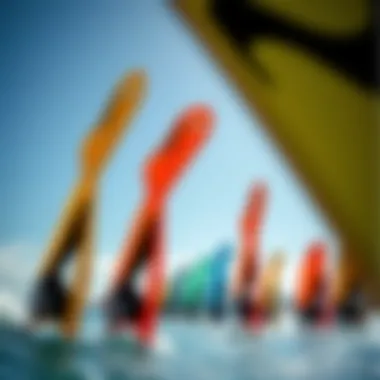
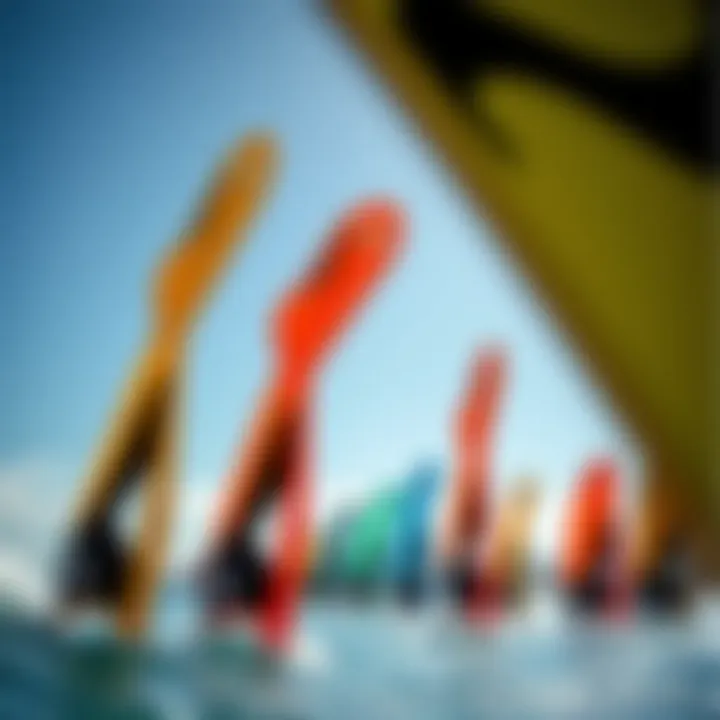
Naish offers several models designed to meet the diverse needs of the wing surfing community. Understanding the differences between these can guide you to the right fit:
- Naish Wing Surfer X: A versatile wing that serves well for both beginners and intermediates. It strikes a balance between ease of use and performance, making it an all-round favorite.
- Naish Wing Surfer Pro: This model is geared towards advanced users who want to push the limits. With a smaller wing size and a more sensitive feel, it’s designed for high-speed sailing and expert maneuvers.
- Naish Wing Surfer Lite: A lightweight choice that enhances agility, perfect for those who prioritize performance in strong winds.
In summary, selecting the right Naish Wing Surfer hinges on a blend of personal preference and informed choices based on size, skill level, and model-specific features. Each aspect informs your experience, making thoughtful selection not just advantageous but essential. As the old saying goes, "you get what you pay for," but with the right information, you can ensure that every dollar spent leads to an exhilarating adventure on the water.
"The journey of a thousand miles begins with one step." — Lao Tzu
By understanding these considerations, you can join the ranks of those who glide through the water with confidence and skill.
Techniques for Optimizing Use
In the realm of wing surfing, mastering effective techniques is as essential as choosing the right equipment. While the Naish Wing Surfer is a remarkable piece of gear, how you handle it can significantly enhance your experience and performance. Proper techniques not only bring out the best in your wing but also allow you to navigate varying conditions with confidence. Embracing these practices can set you on a path to becoming a proficient rider, whether cruising along the coast or tackling challenging waves.
Proper Launching Methods
Launching is often the first hurdle a rider encounters. A smooth take-off can make the difference between a frustrating experience and a successful session on the water. To initiate a proper launch using the Naish Wing Surfer, it’s pivotal to consider wind direction and your positioning.
- Assess the Winds: Before you even touch the wing, check the wind conditions. You want a steady breeze, not sudden gusts that can catch you off guard.
- Wing Positioning: Hold your wing at about a 45-degree angle to the wind. This angle not only lifts the wing but also keeps it under your control.
- Body Orientation: Either place your feet on the board or maintain a grounded stance. This is vital for balance as the wing begins to inflate and provides the necessary control.
- Gradually Rise: Once the wing is inflated, align it with the wind and take a few steps forward, leading into the wind. This will give you the lift required to sail away smoothly.
"A good launch is like a good meal; it sets the tone for the whole ride."
Getting the launch right paves the way for the rest of your adventure. Even after you've mastered this, remember that each session offers unique challenges. Don’t rush; take your time to feel the wind and your wing.
Turning and Riding Techniques
Once you're out on the water, the next challenge is how to maneuver efficiently. Turning and riding techniques can profoundly affect your performance, allowing for agility and grace.
- Body Weight Distribution: Shift your body weight towards the direction where you intend to turn. This simple adjustment can make your transitions smoother and more controlled.
- Using the Wing’s Power: Lean into the wing while edging or turning. This allows the sail to harness the wind, educating it to your advantage.
- Foot Placement: As you carve into a turn, keeping your back foot pressure high helps maintain speed while guiding the wing seamlessly.
- Practice Smooth Transitions: Quick, sharp turns can destabilize your ride. Instead, practice gradual turning arcs to keep the momentum flowing and maintain stability.
Incorporating these techniques fosters a more controlled and enjoyable ride, minimizing the chance of spills and enhancing your confidence on the water.
Advanced Maneuvers and Tricks
When you've got the basics down, it’s time to push your limits. Advanced maneuvers not only impress onlookers but also enhance your skills. Here’s how you can evolve your wing surfing game:
- Jumping: Find a suitable wave or chop. As you approach, compress your knees, then explode upwards while simultaneously pulling gently on the wing. This technique fosters elevation and control.
- Kiteloops: For those who dare, learning kiteloops involves steering the wing in a loop while in the air. This requires precision as you must anticipate the wind flow and wing positioning.
- Backwards Riding: This trick involves turning the board 180 degrees while still maintaining the lift of the wing. It takes practice, but the thrill of riding backwards is unbeatable.
- Transitions: Moving from toe-side to heel-side while maintaining speed is a advanced maneuver that requires finesse. Practice moving weight fluidly between foot placements to master this skill.
Fine-tuning these advanced techniques isn't just about adding flair; it's about enhancing your versatility across different water conditions.
Mastering these techniques for the Naish Wing Surfer offers more than just a fun time in the water; it unlocks new possibilities and experiences. Whether you're aiming to ride smooth or ready to perform tricks, understanding and employing the proper methods can elevate your wing surfing journey.
Maintenance and Care for the Naish Wing Surfer
The performance and longevity of the Naish Wing Surfer rely significantly on proper maintenance and care. Owning such a sophisticated piece of equipment demands more than just passion for wing surfing; it requires diligence in looking after your gear. Here, we’ll explore how cleaning, storing, and inspecting your wing surfer can extend its lifespan and enhance your riding experience.
Cleaning and Storage
Regular cleaning and correct storage are paramount to maintaining your Naish Wing Surfer in tip-top shape. After every session, especially in salty or sandy environments, giving your wing a proper rinse can be a big game-changer.
Why Clean? Salt, sand, and debris can be insidious, slowly eating away at materials over time. A good wash with clean, fresh water helps in removing these nuisances.
Storage Techniques:
- Store in a cool, dry place: Heat and moisture can degrade the materials.
- Avoid direct sunlight: UV rays can warp or weaken the fabric.
- Use a bag: Employ a storage bag to prevent abrasions and scratches.
When it’s time to pack your gear, ensure it’s completely dry before placing it in storage. You wouldn't want to end your season with a damp wing, inviting mold or mildew to join the party!
Repair Techniques for Common Issues
Even with the best care, issues might crop up. Understanding basic repair techniques can save you both time and money, keeping you out on the water instead of sidelined.
Common Problems:
- Small punctures or leaks: These can usually be patched with a repair kit from Naish or a similar brand. Look for the tear and apply a patch consistent with the material of your wing.
- Straps or handles coming loose: Inspect these often. They can sometimes be tightened with a simple screwdriver or re-sewn if they’re coming apart.
Repair Steps:
- Identify the issue and gather your tools such as a patch kit, adhesive, or stitches if needed.
- For punctures: Clean the area, let it dry, then apply the patch.
- For handles: Tighten screws or replace them if broken.
Acting promptly can prevent larger issues down the line, ensuring you’re ready for your next adventure.
Seasonal Inspections
Just as you would rotate the tires on a car or do a quarterly check on your home, giving your Naish Wing Surfer a thorough inspection at the start of each season is a smart move.
Inspection Checklist:
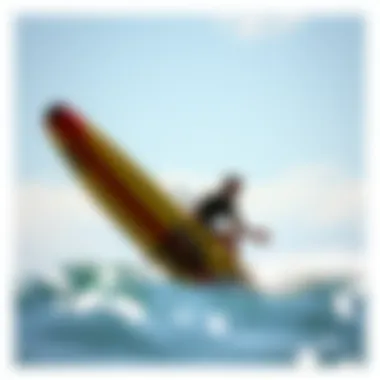
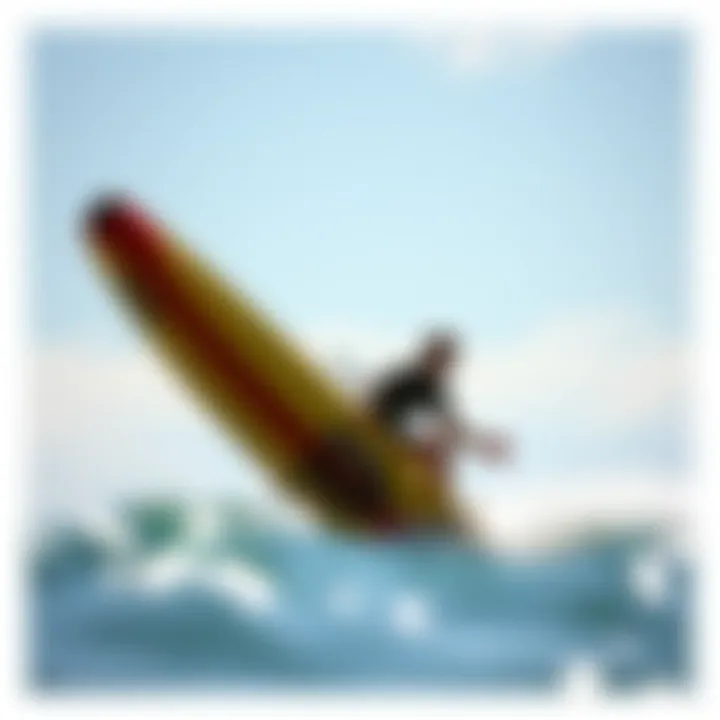
- Check for leaks: Inflate your wing and listen for hissing sounds. A visual inspection can also help spot any wear and tear.
- Inspect seams: Pay attention to the stitching, as frayed threads could lead to catastrophic failures during use.
- Look at handles and straps: Ensure everything is secure and functioning correctly.
A stitch in time saves nine; it’s far better to fix small problems than to wait until they become major headaches.
By following these maintenance tips and understanding the importance of care, you will greatly enhance your experience with the Naish Wing Surfer. It’s about creating memories on the water without the worries tied to gear malfunction, keeping your enjoyment as the main focus.
Safety Considerations in Wing Surfing
When it comes to wing surfing, one can’t overlook the paramount importance of safety. The exhilarating rush of gliding over water, aided by wind and your trusty Naish Wing Surfer, can quickly turn into a precarious situation if safety isn't a top priority. The blend of thrill and unpredictability that comes with this sport demands that every enthusiast, from the green beginner to the seasoned pro, adopt a safety-first mindset. This section discusses essential safety gear, the significance of understanding weather conditions, and the importance of practicing safe riding techniques.
Essential Safety Gear
To enjoy wing surfing without compromising on safety, gearing up with the right equipment is crucial. Essential safety gear can be the difference between a thrilling ride and a hazardous experience. Here’s a breakdown of must-have items:
- PFD (Personal Flotation Device): Always wear a buoyancy aid, particularly in unpredictable waters.
- Helmet: Protects your head in case of falls or collisions.
- Impact Vest: Provides additional protection against falls and abrasions.
- Leash: Keeping your wing close ensures that you don’t lose control or have it carried away by the wind.
- Footwear: Sturdy shoes or booties can protect your feet from sharp objects, especially when launching or landing on the beach.
This gear not only safeguards against physical injuries but also instills confidence. When you know you're protected, you can focus on enjoying the ride.
Understanding Weather Conditions
Weather plays a critical role in wing surfing. Understanding the elements can help prevent mishaps while enhancing the overall experience. Here are key factors to consider:
- Wind Strength: Ideal wind speeds usually range between 10-25 knots for most wing surfers. Overstating your abilities in strong winds can be risky.
- Wind Direction: Knowing how wind interacts with local geography (like islands, buildings, and hills) can help you predict gusts and shifts.
- Water Conditions: Awareness of water conditions such as current patterns, wave height, and temperature is vital in choosing when and where to surf.
- Local Weather Changes: Always check forecasts before heading out. Conditions can morph quickly, and being caught off guard can lead to perilous situations.
By being informed about weather conditions, you can make educated decisions that affect your safety and enjoyment.
Practicing Safe Riding Techniques
Mastering safe riding techniques is as important as having the right gear. Incorrect techniques can lead to accidents, which can easily be avoided. Here are some key practices to adopt:
- Start Slow: Don’t rush into advanced maneuvers. Begin with basic riding and progress at your own pace.
- Body Position: Keep your weight centered over the board. Leaning too far forward or backward can lead to a wipeout.
- Vision: Always look where you’re going. It’s easy to get distracted, but maintaining focus can help you anticipate obstacles.
- Emergency Drills: Practice what to do in different emergencies, whether it's a sudden gust or losing your wing. Knowing how to respond can prevent panic.
In addition, maintain strong situational awareness. Watch for fellow surfers and navigate accordingly.
"A moment's inattention can lead to a lifetime of regret." Being vigilant in your practices can contribute significantly to a safer experience for you and those around you.
In summary, prioritizing safety gear, understanding weather, and practicing safe techniques equips wing surfers with the necessary knowledge and tools to enjoy the sport. These factors are not merely suggestions; they are vital components that enhance both performance and enjoyment, keeping the fun alive while managing the associated risks.
The Broader Context of Wing Surfing
The development of wing surfing has certainly shaken things up in the water sports community. Wing surfing distinguishes itself through its unique blend of elements borrowed from both kiteboarding and windsurfing. This distinctive element allows a wider range of participants to engage in the sport. However, it's not just about riding the wind or the waves; various factors intersect in this sport's growth, helping to place it in a larger ecosystem of aquatic activities, all of which this article aims to explore.
Wing Surfing vs. Kiteboarding
Wing surfing and kiteboarding often swirl around in discussions about modern water sports, but each has its distinctive traits. While kiteboarding uses a large kite tethered to a harness, wing surfing involves a handheld wing that offers more versatility and freedom of movement. This difference significantly impacts technique and experience.
For instance, the learning curve for wing surfing might be less steep, once you grasp the basic techniques. The freedom associated with wing surfing allows for a greater playful exploration of techniques like jumping and tricks since you are not tethered to a steering system.
Also, mistakes made while out in the water feel less perilous, as the wing’s nature offers a certain degree of control and emergency recovery. While kiteboarding enthusiasts may relish the adrenaline rush, wing surfers enjoy a more approachable challenge without the complex rigging and de-rigging process inherent in kiteboarding gear.
Integration into Water Sports Communities
The community surrounding wing surfing may not be as vast as that of kiteboarding, but it's steadily gaining traction. Social media platforms like Facebook and discussion boards on Reddit have become hive mines for enthusiasts to share tips, locations, and gear reviews. People are bonding over communal experiences and exhibition events, bridging gaps between different segments of the water sports community.
In fact, many surf schools are beginning to integrate wing surfing lessons into their curriculums, allowing newcomers an entry point into multiple functions of water sports. This integration helps inform the broader community about what wing surfing entails, nurturing a welcoming atmosphere for all skill levels. It’s a remarkable thing to see how people from different backgrounds come together at the beach; exchanging ideas, techniques, and stories while enjoying the adrenaline of the sport.
Environmental Considerations
As with any activity involving natural resources, wing surfing comes with its share of environmental considerations. It’s essential to recognize the impact that water sports can have on marine life and ecosystems. Riders are encouraged to practice “Leave No Trace” principles, ensuring that our beloved beaches and waterways remain pristine.
Being mindful of your surroundings while wing surfing augments not only the experience but also improves the health of coastal environments.
Key Points to Remember:
- Opt for eco-friendly equipment. Manufacturers are introducing sustainable materials into their wing designs.
- Mind the wildlife. Being aware of nesting and breeding seasons for local fauna can help minimize disturbances to their habitats.
- Engage in clean-up activities. Organizing and participating in beach clean-ups can significantly contribute to the preservation of nature, creating a positive image for the sport.
To sum it up, the broader context of wing surfing is far more than just grasping the wind and riding waves. It's a confluence of technology, community, and environmental awareness fitting seamlessly into the modern fabric of water sports. As wing surfing evolves, it remains crucial to embrace these various elements that give depth and diversity to the sport while respecting the environments we cherish.
"The ocean stirs the heart, inspires the imagination, and brings eternal joy to the soul."
Finale
As we wrap up this exploration of the Naish Wing Surfer, it becomes clear that this piece of equipment is not merely a tool for riding the waves; it’s a gateway to a vibrant community and an exhilarating experience on the water. The Naish Wing Surfer encapsulates advancements in design, performance, and safety, making it a preferred choice for many. Understanding its nuances is vital, especially when considering the wide range of skill levels it caters to.
Final Thoughts on the Naish Wing Surfer
In reflecting on the Naish Wing Surfer, one must acknowledge both its technical prowess and its ability to elevate your enjoyment. The wing's design not only enhances performance but also offers unique handling characteristics that can make or break your riding experience. Furthermore, its adaptability means whether you’re carving through swells or gently gliding along calm waters, the Naish Wing Surfer delivers. Familiarity with its features ensures not only better performance but also prolongs the life of the equipment, benefiting both the user and the environment by reducing waste.
"The Naish Wing Surfer is about more than just riding; it’s about connecting with nature and mastering a new skill."
The Future of Wing Surfing
Looking ahead, the future of wing surfing seems bright. With continuous innovation, manufacturers like Naish are likely to enhance the performance of wings even further, incorporating new materials and tech that promise lighter, stronger wings with improved aerodynamics. Moreover, the growing popularity of wing surfing is driving interest from diverse groups, including younger athletes and casual enthusiasts, which suggests that this sport will keep expanding its reach.
In addition, awareness regarding environmental sustainability is growing. Future designs may also focus on eco-friendly materials and production practices. This aspect resonates well with the rising number of riders who are looking to enjoy the great outdoors while also being stewards of it. The wind and water are part of our world, and responsible riding means coexisting with nature, not against it.
As the sport continues to evolve, so too will the community that surrounds it, mixing the thrill of adventure with shared knowledge and collective growth. For dedicated enthusiasts, the Naish Wing Surfer is just the tip of the iceberg – an entry point into a dynamic, engaging world that is unfolding on the waters of our planet.















